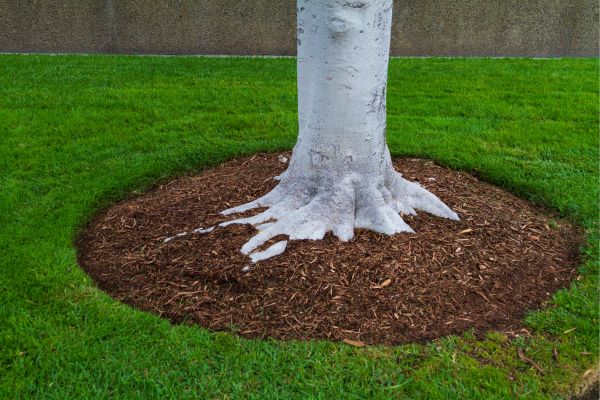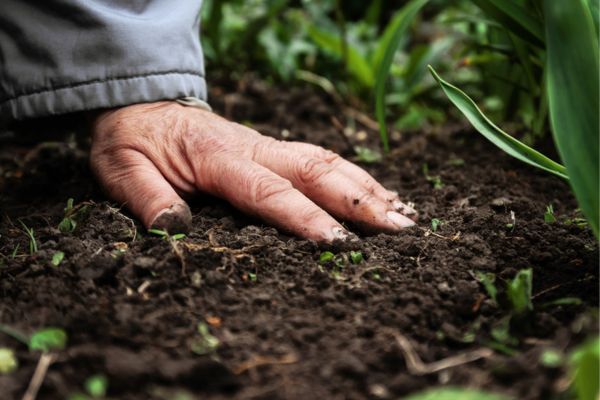Mulching around trees can greatly benefit their growth and health because proper mulching provides moisture retention, weed control, and temperature regulation. But how do you apply mulch around trees correctly? We’ll guide you through the process of proper mulching. Additionally, we’ll discuss what types of mulch to use and how to apply mulch around the tree. We will also share common mistakes to avoid.
Should You Apply Mulch Around the Base of a Tree?
Yes, you should apply mulch around the base of a tree because mulch serves several vital purposes. First, it retains moisture in the soil and moisture is essential for healthy tree roots. Second, it helps regulate soil temperature, keeping it cooler in the summer and warmer in the winter. Third, mulch suppresses weed growth. Weeds compete with the tree for nutrients and water. Finally, mulch improves the soil’s fertility as it decomposes.
 What Kind of Mulch Should You Use?
What Kind of Mulch Should You Use?
The best type of mulch for trees depends on several factors: the tree species, location, and climate. Here are the most common types of mulch:
1. Shredded Hardwood Mulch
Shredded hardwood is a great mulch for most trees because it breaks down slowly. This provides long-term benefits to the soil. Shredded hardwood mulch is good at moisture retention and weed suppression and it also offers a natural appearance that blends well with most landscapes.
2. Bark Mulch
Bark mulch is made from the outer layers of trees like pine, cedar, and fir. Correspondingly, it is chunkier than shredded hardwood mulch. Also, bark mulch is durable and slowly breaks down, providing long-lasting coverage. Its coarse texture allows air to circulate around the tree roots, which is essential for their health. It also has good moisture retention properties. However, if the tree is young or newly planted, its coarse texture makes it harder for water to reach the roots.
3. Wood Chips
Wood chips are another popular mulch option because they decompose slowly, providing nutrients to the soil over time. They tend to retain less moisture than shredded hardwood or bark mulch. Therefore, they are best used around trees in areas that have a regular supply of water. They are also ideal for areas where a larger quantity of mulch is needed.
4. Pine Needles (Pine Straw)
Pine needles are a more acidic mulch option and they are well-suited to trees that thrive in acidic soil. This includes pines, azaleas, and rhododendrons. Pine straw decomposes quickly, so it may require reapplying more frequently. Pine needles are lightweight and easy to spread, so this makes them a good choice for smaller trees.
5. Compost
Compost can be used as mulch, especially for trees that require nutrient-rich soil. It is rich in organic matter, which improves soil fertility. Compost breaks down faster than bark or shredded hardwood. But it still provides moisture retention and weed suppression benefits. If you are using compost, spread it evenly around the tree and avoid piling it against the trunk.
How to Apply Mulch Around Trees
It is essential to apply mulch around trees correctly. Improper mulching can lead to damage. Piling mulch directly against the trunk can encourage rot and attract pests. These problems can weaken or kill a tree. Follow these steps to apply mulch around a tree properly:
Step 1: Clear the Area Around the Tree
Grass and weeds compete with your tree for water, nutrients, and space, so you need to remove them. Use a shovel, hoe, or weeding tool to clear the area around the tree. Remove grass, weeds, or debris around the base of the tree, while avoiding damaging the tree roots in the process. If the ground around the tree is uneven, level it out with a rake. This will make it easier to apply an even layer of mulch. This also helps with water distribution once it rains, or you water the tree.
Step 2: Prepare the Soil
Preparing the soil ensures the tree’s roots receive oxygen, water, and nutrients they need to grow. The soil around a tree compacts over time. Compacted soil restricts the flow of water, air, and nutrients to the tree roots, therefore making it harder for the tree to grow. Aerating the soil helps the tree’s roots access water and nutrients.
Lightly aerate the soil using a garden fork or soil aerator. Poke holes around the tree base to improve air flow and allow water to penetrate deeper into the soil. This improves water and air penetration. Be careful not to disturb the roots. After aerating, assess the drainage around the tree. Poor drainage can lead to waterlogged soil. Waterlogged soil suffocates the roots and causes root rot.
Step 3: Apply the Mulch
This isn’t as obvious as it sounds. How you apply it directly affects the tree’s health, so you’ll want to follow these tips. Spread the mulch around the tree, starting about 6 to 12 inches away from the trunk and create a uniform layer around the base of the tree. Aim for a mulch depth of about 2 to 4 inches. If the mulch is too thick, it can suffocate the tree’s roots. Too thin a layer will not provide the desired benefits.
For large trees, you may need to increase the mulch radius. Make sure the mulch forms a donut shape. Do not let mulch touch the trunk. Mulch piled directly against the trunk can cause rot and attract pests.
 Step 4: Maintain the Mulch Layer
Step 4: Maintain the Mulch Layer
Mulch breaks down over time, so it will need to be replenished. Maintenance is key so the mulch continues to provide benefits to your tree. Check the mulch layer regularly. This will ensure it’s still providing the necessary benefits. Add more mulch around trees as needed. Again, avoid piling it up against the trunk. Rake the mulch every few months, therefore ensuring even distribution and avoids compaction.
Common Mulching Mistakes to Avoid
Mulching seems like a simple task. However, there are common mistakes that homeowners and landscapers make when applying mulch around trees. Here are a few to avoid:
1. Mulch Piling Against the Tree Trunk
As mentioned earlier, one of the most common mistakes is piling mulch directly against the tree trunk. This leads to moisture buildup. That buildup creates a perfect environment for fungi and pests. Over time, this leads to rot and other health problems. Always maintain a gap of at least 6 inches between the trunk and the mulch.
2. Using Too Much Mulch Around Trees
Avoid applying too thick a layer of mulch. More isn’t always better. A 2- to 4-inch layer of mulch is usually sufficient for most trees. Anything thicker suffocates the roots and restricts water and air penetration. It can also make the mulch more prone to compacting.
3. Mulching Too Early or Too Late
Mulch in the spring after the soil warms. Or mulch in the fall, after the last frost of the season. Mulching too early delays the tree’s ability to warm up in the spring. Mulching too late in the fall prevents the soil from freezing properly. Proper freezing is essential for the tree’s dormancy cycle.
4. Not Watering After Mulching
Mulch around trees helps retain moisture. Much does not create moisture. After applying mulch, water the area thoroughly. This helps the tree’s roots absorb the water. Mulch can dry out in hot weather. Regularly water to ensure the tree gets the moisture it needs.
5. Using the Wrong Type of Mulch
Not all mulch is suitable for every tree. Some trees need acidic or nutrient-rich mulch. Others thrive with coarse mulch like bark or shredded hardwood. Choose your mulch based on your tree’s specific needs. Avoid using mulches with pesticides or herbicides. These can harm your tree.
Mulching for Commercial Landscaping
Landscaping enhances a commercial property’s aesthetics while supporting tree health, therefore following these same principles when applying mulch on commercial building grounds will accomplish these goals.
Consider larger-scale mulching techniques for commercial properties. Use durable mulches that withstand foot traffic and weather conditions. In high-traffic areas, bark mulch or wood chips may be preferable. They won’t compact as easily. Regular mulching and maintenance schedules are crucial. This ensures the long-term health of trees in commercial environments.
Proper Mulching is Critical
Mulching your trees properly is a small effort that brings big benefits. Also, mulching protects against pests and disease. When you mulch around trees it supports healthy growth. Proper mulching provides moisture retention, temperature regulation, and weed suppression. Mulching dramatically improves a tree’s health and longevity.
Proper mulching involves choosing the right mulch for your trees. It requires clearing the area of weeds and debris. And applying the mulch in the right way. We are here to help guide you through the steps. If you’re looking for a high-quality mulch provider in Chicagoland, Lumberjacks will help determine how much mulch you need and help you select the mulch that is best for your needs. We’ll go over proper mulching techniques and mistakes to avoid. We are here to answer all your questions about applying mulch around trees. Contact us today to learn more!








